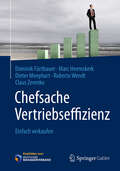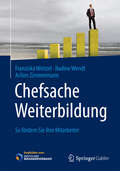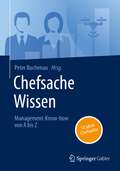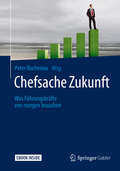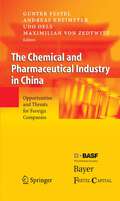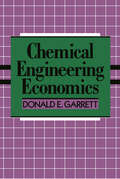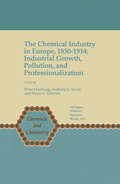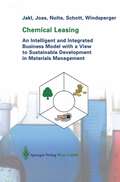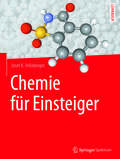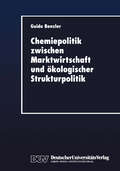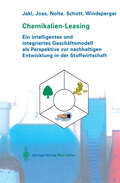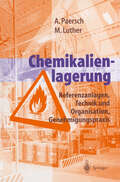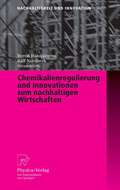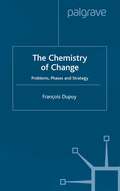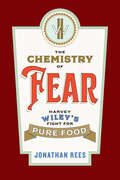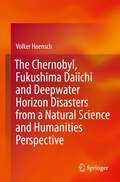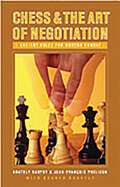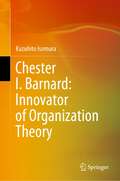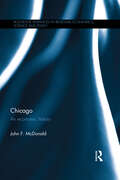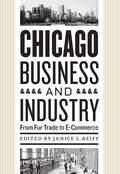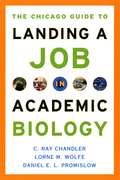- Table View
- List View
Chefsache Vertriebseffizienz: Einfach verkaufen
by Dominik Fürtbauer Marc Heemskerk Dieter Menyhart Roberto Wendt Claus Zerenko Peter BuchenauDas Fachbuch stattet Vertriebsmitarbeiter mit einem Ideenkoffer an Vertriebsmethoden aus, um den künftigen Kundenanforderungen am Markt gerecht zu werden. Auf Grund der Globalisierung und Technologisierung haben sich die Vertriebsstrategien in den letzten Jahren massiv verändert. Die Generation Y verkauft anders als die Generation X. Social-Media-Vertrieb steckt immer noch in den Kinderschuhen, wird aber von Jahr zu Jahr wichtiger. Die herkömmlichen Vertriebsmethoden müssen überdacht und angepasst werden. Fünf Vertriebsprofis aus drei Ländern im Alter von 25-55 Jahren zeigen auf, welche Vertriebswege morgen zum Erfolg führen.
Chefsache Weiterbildung: So fördern Sie Ihre Mitarbeiter
by Franziska Weitzel Nadine Wendt Achim Zimmermann Peter BuchenauDas Fachbuch beleuchtet das Thema Weiterbildung von allen Seiten und geht dabei sowohl auf die strategische Weiterbildung mit Blick auf die Unternehmensentwicklung als auch die Weiterbildung als persönliche Potenzialentfaltung ein. Welche Veränderungen und neuen Blickwinkel sind nötig, um wettbewerbsfähig zu bleiben? Wo bestehen Gefahren und Chancen? Wie lässt sich der Bedarf an Weiterbildungsmaßnahmen ermitteln? Welche sind die Schlüsselqualifikationen für das 21. Jahrhundert? Die Autoren zeigen, wie Weiterbildungs- und Wissensmanagement gewinnbringend in das Unternehmen eingebracht werden können. Außerdem wird erläutert, welche rechtlichen Grundlagen für die Weiterbildung im Betrieb aus Arbeitsnehmer- und Arbeitgebersicht zu beachten sind.
Chefsache Wissen: Management-Know-how von A bis Z (Chefsache)
by Peter BuchenauVon der Arbeitswelt 5.0 über Digitalisierung, Motivation und Wertschätzung bis zur Zukunft des Handelns: In diesem Jubiläumsband erhalten Sie einen Überblick zu 26 Chefsache-Themen von A bis Z – wie immer lehrreich, praxisorientiert und umsetzbar. Neben den Softskills steht vor allem das Thema Veränderung im Fokus. Die Autoren sind gefragte Experten zum Thema Management und Führung, die internationale Konzerne, aber auch kleine und mittelständische Unternehmen beraten und genau wissen, worauf es wirklich ankommt. In ihren Beiträgen geben sie Unternehmern, Führungskräften und Chefs die Tools an die Hand, um Erfolge zu sichern und neue zu schaffen.
Chefsache Zukunft: Was Führungskräfte von morgen brauchen (Chefsache)
by Peter BuchenauDie Digitalisierung bedeutet mehr als nur Breitbandausbau. Die Digitalisierung wird in alle Lebensbereiche und Lebensformen einziehen. Das Zusammenleben zwischen Roboter und Mensch wird zum zentralen Mittelpunkt. Doch darf bei diesem digitalen Fortschritt der Mensch mit seinen Gefühlen, Ängsten und Emotionen nicht vergessen werden. 31 Unternehmer, Berater und Coaches wagen deshalb in diesem Buch einen Blick in die Zukunft und beschreiben wie sich das Leben und Arbeiten in den nächsten 10 Jahren in ihrem jeweiligen Fachgebiet, wie u.a. die Führung, der Vertrieb, die Umsetzung, die Gesundheit und die Sicherheit von Menschen im Unternehmen und somit auch in der Gesellschaft von Morgen, verändern werden. Die Autorinnen und Autoren geben Zuversicht und machen Mut, sich auf die Anforderungen der Zukunft vorbereiten zu können.
The Chemical and Pharmaceutical Industry in China: Opportunities and Threats for Foreign Companies
by G. Festel A. Kreimeyer U. Oels Maximilian Von ZedtwitzA detailed examination of China’s increasingly important chemical and pharmaceutical industry. Numerous case studies describe how western companies, such as BASF, Bayer, Bicoll, Ciba, Degussa, DSM and Novartis are managing their market entry in China.
Chemical Engineering Economics
by D.E. Garrettleast, the author wishes to thank his constantly helpful wife Maggie and his secretary Pat Weimer; the former for her patience, encouragement, and for acting as a sounding-board, and the latter who toiled endlessly, cheerfully, and most competently on the book's preparation. CONTENTS Preface / iii 1. INTRODUCTION / 1 Frequently Used Economic Studies / 2 Basic Economic Subjects / 3 Priorities / 3 Problems / 6 Appendixes / 6 References / 6 2. EQUIPMENT COST ESTIMATING / 8 Manufacturers' Quotations / 8 Estimating Charts / 10 Size Factoring Exponents / 11 Inflation Cost Indexes / 13 Installation Factor / 16 Module Factor / 18 Estimating Accuracy / 19 Estimating Example / 19 References / 21 3. PLANT COST ESTIMATES / 22 Accuracy and Costs of Estimates / 22 Cost Overruns / 25 Plant Cost Estimating Factors / 26 Equipment Installation / 28 Instrumentation / 30 v vi CONTENTS Piping / 30 Insulation / 30 Electrical / 30 Buildings / 32 Environmental Control / 32 Painting, Fire Protection, Safety Miscellaneous / 32 Yard Improvements / 32 Utilities / 32 Land / 33 Construction and Engineering Expense, Contractor's Fee, Contingency / 33 Total Multiplier / 34 Complete Plant Estimating Charts / 34 Cost per Ton of Product / 35 Capital Ratio (Turnover Ratio) / 35 Factoring Exponents / 37 Plant Modifications / 38 Other Components of Total Capital Investment / 38 Off-Site Facilities / 38 Distribution Facilities / 39 Research and Development, Engineering, Licensing / 40 Working Capital / 40
The Chemical Industry in Europe, 1850–1914: Industrial Growth, Pollution, and Professionalization (Chemists and Chemistry #17)
by Ernst Homburg Anthony S. Travis Harm G. SchröterEurope is the cradle of the modem international chemical industry. From the middle of the nineteenth century until the outbreak of World War I, the European chemical industry influenced not only the production and control of science and technology, but also made significant contributions towards economic development, as well as bringing about profound changes in working and living enviromnents. It is a highly complex heritage, both rich and threatening, that calls for close scrutinity. Fortunately, a unique opportunity to explore the historical development of the European chemical industry from a variety of novel standpoints, was made possible during 1993 as part of the European Science Foundation (ESF) programme called 'The Evolution of Chemistry in Europe, 1789-1939.' This process of exploration has taken place through three workshops, each dealing with different time periods. The workshop concerned with the period 1850-1914, which corresponds roughly to the so-called Second Industrial Revolution, was held in Maastricht, The Netherlands, on 23-25 March 1995. This volume is the outcome of that workshop. The other workshops dealing with European chemical industry were held in Liege in 1994, covering the First Industrial Revolution period, 1789-1850, and Strasbourg in 1996, covering the period between the two World Wars.
Chemical Leasing: An Intelligent and Integrated Business Model with a View to Sustainable Development in Materials Management
by Thomas Jakl Reinhard Joas Rainer Nolte Rudolf Schott Andreas Windsperger"Chemical leasing” represents an innovative business model, in which chemicals are no longer simply sold to the customer to render a specific service, but made available and maintained. This way, the economic interest no longer lies in selling the chemical product, but in providing a chemical service. All the stakeholders will thus endeavour to enhance the efficiency of the various substances to a maximum. This book is based on the results of two studies facilitated by the Austrian Ministry of Environment and key players of the industry, in which the potentials for the introduction of such a business model for Austria were investigated. A classical "win–win” solution evolves, which spares the environment by reducing emissions, gives rise to an optimisation of company processes, both in terms of quality and quantity, and redefines the supplier – customer relationship.
Chemie für Einsteiger
by Josef K. FelixbergerDas Buch ist eine leicht verständliche Einführung in die Welt der Chemie mit hohem praktischem Nutzen, angereichert mit zahlreichen anschaulichen Beispielen aus Alltag, Industrie, Wirtschaft, Politik und Geschichte. Eine reich bebilderte Darstellung der Allgemeinen und Anorganischen Chemie, der Organischen Chemie und Biochemie und last, but not least der Polymerchemie und Kunststoffverarbeitung. Gleichermaßen empfehlenswert für Studienanfänger mit Nebenfach Chemie, für Kaufleute und Techniker, Schüler und Lehrer sowie für interessierte Laien.
Chemiepolitik zwischen Marktwirtschaft und ökologischer Strukturpolitik: Ein ökonomischer Beitrag zum Umgang mit Produktrisiken in der Chemischen Industrie (DUV Wirtschaftswissenschaft)
by Guido BenzlerIm Gegensatz zur meist naturwissenschaftlich und ökonomisch-interventionistisch geführten chemiepolitischen Diskussion setzt sich der Autor mit der Notwendigkeit einer expliziten Lenkung der Entwicklung der Chemischen Industrie auseinander.
Chemikalien-Leasing: Ein intelligentes und integriertes Geschäftsmodell als Perspektive zur nachhaltigen Entwicklung in der Stoffwirtschaft
by Thomas Jakl Reinhard Joas Rainer F. Nolte Rudolf Schott Andreas Windsperger"Chemikalien-Leasing" steht für ein innovatives Geschäftsmodell, bei dem Chemikalien zur Verrichtung einer bestimmten Dienstleistung nicht mehr bloß an den Kunden verkauft, sondern zum Gebrauch zur Verfügung gestellt und gewartet werden. Damit ist das wirtschaftliche Interesse nicht mehr an den Verkauf der Chemikalie gebunden, sondern an den Absatz einer chemischen Dienstleistung. Es liegt daher im Interesse aller Beteiligten, den jeweiligen Stoff mit einem Maximum an Effizienz einzusetzen. Das vorliegende Buch fußt auf den Ergebnissen zweier vom österreichischen Umweltministerium und den Key-Players der Wirtschaft geförderten Studien, welche die Möglichkeiten für die Einführung eines solchen Geschäftsmodells für Österreich erhoben haben. Eine klassische "win – win"-Lösung stellt sich ein, die der Umwelt Emissionen erspart, zu einer qualitativen und quantitativen Optimierung innerbetrieblicher Abläufe führt und das Verhältnis Anbieter – Kunde neu definiert.
Chemikalienlagerung: Referenzanlagen, Technik und Organisation, Genehmigungspraxis
by Andreas Paersch Martina LutherChemikalien werden vielerorts und in größeren Mengen in Lagerbetrieben, beim Handel und in Produktionsbetrieben gelagert. Oft genug werden die vielen komplizierten Vorschriften nicht eingehalten. Andererseits gibt es in Deutschland aber schon eine Reihe von modernen sicheren Chemikalienlagern für Gefahrgut, Gefahrstoffe und wassergefährdende Stoffe.Diese Anlagen setzen die Maßstäbe für die erforderliche Sicherheit und sind die Grundlage für dieses Praxishandbuch:- Der Schwerpunkt ist die systematische Gegenüberstellung von Referenzanlagen in Tabellen. - Über Details wird umfassend und übersichtlich mit schnellem Zugriff informiert, ebenfalls in Tabellenform. - Das Wichtigste über Genehmigungsverfahren, zugeschnitten auf Chemikalienlager, wird verständlich dargestellt; behördliche Formulare sind abgedruckt. - Mit den Referenzanlagen kann der Stand der Sicherheitstechnik ohne Umwege ermittelt werden.
Chemikalienregulierung und Innovationen zum nachhaltigen Wirtschaften (Nachhaltigkeit und Innovation)
by Bernd Hansjürgens Ralf NordbeckDie europäische Chemikalienregulierung steht auf dem Prüfstand. Mit dem kontrovers diskutierten REACH-System soll einerseits ein Beitrag zu einem verbesserten Gesundheits-, Umwelt- und Verbraucherschutz geleistet werden, andererseits sollen Innovationen in den europäischen Volkswirtschaften nicht behindert werden, um wirtschaftliche Entwicklung und Wohlstand zu ermöglichen. Der vorliegende Band analysiert die Bestimmungsgründe für Innovationen zum nachhaltigen Wirtschaften, untersucht die Effektivität und die Innovationswirkungen der bestehenden Chemikalienregulierung sowie des neuen REACH-Systems, diskutiert Verfahren der Risikobewertung und entwickelt Vorschläge zu alternativen Regelungsformen. Das Buch richtet sich sowohl an Wissenschaftler und Studierende, die an Innovationstheorie interessiert sind, als auch an Praktiker im Bereich der europäischen Chemikalienpolitik.
The Chemistry of Change: Problems, Phases and Strategy
by F. DupuyFollowing on from his previous book, The Customer's Victory , François Dupuy here outlines how to manage a change process. Using practical examples from new case studies and discussion of current theories of organisational change this book explains how true organisational change can be effected in both private businesses and public organisations. With a strong pedagogical format, case studies and a helpful glossary of terms, this is an invaluable guide both for managers having to deal with change implementation and for students and researchers of change management.
The Chemistry of Fear: Harvey Wiley's Fight for Pure Food
by Jonathan ReesA fascinating examination of the controversial work of Harvey Wiley, the founder of the pure food movement and an early crusader against the use of additives and preservatives in food.Though trained as a medical doctor, chemist Harvey Wiley spent most of his professional life advocating for "pure food"—food free of both adulterants and preservatives. A strong proponent of the Pure Food and Drug Act of 1906, still the basis of food safety legislation in the United States, Wiley gained fame for what became known as the Poison Squad experiments—a series of tests in which, to learn more about the effects of various chemicals on the human body, Wiley's own employees at the Department of Agriculture agreed to consume food mixed with significant amounts of various additives, including borax, saltpeter, copper sulfate, sulfuric acid, and formaldehyde. One hundred years later, Wiley's influence lives on in many of our current popular ideas about food: that the wrong food can kill you; that the right food can extend your life; that additives are unnatural; and that unnatural food is unhealthy food. Eating—the process of taking something external in the world and putting it inside of you—has always been an intimate act, but it was Harvey Wiley who first turned it into a matter of life or death.In The Chemistry of Fear, Jonathan Rees examines Wiley's many—and varied—conflicts and clashes over food safety, including the adulteration of honey and the addition of caffeine to Coca-Cola, formaldehyde to milk, and alum to baking powder. Although Wiley is often depicted as an unwavering champion of the consumer's interest, Rees argues that his critics rightfully questioned some of his motivations, as well as the conclusions that he drew from his most important scientific work. And although Wiley's fame and popularity gave him enormous influence, Rees reveals that his impact on what Americans eat depends more upon fear than it does upon the quality of his research. Exploring in detail the battles Wiley picked over the way various foods and drinks were made and marketed, The Chemistry of Fear touches upon every stage of his career as a pure food advocate. From his initial work in Washington researching food adulteration, through the long interval at the end of his life when he worked for Good Housekeeping, Wiley often wrote about the people who prevented him from making the pure food law as effective as he thought it should have been. This engaging book will interest anyone who's curious about the pitfalls that eaters faced at the turn of the twentieth century.
The Chemistry of Fear: Harvey Wiley's Fight for Pure Food
by Jonathan ReesA fascinating examination of the controversial work of Harvey Wiley, the founder of the pure food movement and an early crusader against the use of additives and preservatives in food.Though trained as a medical doctor, chemist Harvey Wiley spent most of his professional life advocating for "pure food"—food free of both adulterants and preservatives. A strong proponent of the Pure Food and Drug Act of 1906, still the basis of food safety legislation in the United States, Wiley gained fame for what became known as the Poison Squad experiments—a series of tests in which, to learn more about the effects of various chemicals on the human body, Wiley's own employees at the Department of Agriculture agreed to consume food mixed with significant amounts of various additives, including borax, saltpeter, copper sulfate, sulfuric acid, and formaldehyde. One hundred years later, Wiley's influence lives on in many of our current popular ideas about food: that the wrong food can kill you; that the right food can extend your life; that additives are unnatural; and that unnatural food is unhealthy food. Eating—the process of taking something external in the world and putting it inside of you—has always been an intimate act, but it was Harvey Wiley who first turned it into a matter of life or death.In The Chemistry of Fear, Jonathan Rees examines Wiley's many—and varied—conflicts and clashes over food safety, including the adulteration of honey and the addition of caffeine to Coca-Cola, formaldehyde to milk, and alum to baking powder. Although Wiley is often depicted as an unwavering champion of the consumer's interest, Rees argues that his critics rightfully questioned some of his motivations, as well as the conclusions that he drew from his most important scientific work. And although Wiley's fame and popularity gave him enormous influence, Rees reveals that his impact on what Americans eat depends more upon fear than it does upon the quality of his research. Exploring in detail the battles Wiley picked over the way various foods and drinks were made and marketed, The Chemistry of Fear touches upon every stage of his career as a pure food advocate. From his initial work in Washington researching food adulteration, through the long interval at the end of his life when he worked for Good Housekeeping, Wiley often wrote about the people who prevented him from making the pure food law as effective as he thought it should have been. This engaging book will interest anyone who's curious about the pitfalls that eaters faced at the turn of the twentieth century.
The Chernobyl, Fukushima Daiichi and Deepwater Horizon Disasters from a Natural Science and Humanities Perspective
by Volker HoenschIn our everyday imaginations we use the laws of nature with their tremendous possibilities of technical progress for the benefit of mankind. The three catastrophes of Chernobyl (26 April 1986), Fukushima Daichii (11 March 2011) and in the Gulf of Mexico, explosion of the drilling platform Deepwater Horizon (20 April 2010), have shaken this world view. Who directed this development? Is it a matter of human error or technical failure? For the answer, approaches from the natural sciences and the humanities are presented.
Chess and the Art of Negotiation: Ancient Rules for Modern Combat
by Anatoly Karpov Jean-Fran Phelizon Bachar KouatlyNegotiations and other business maneuvers are like chess: every move generates a plethora of potential next moves. In Chess and the Art of Negotiation, a world-renowned chess master and a CEO of a global company join forces and apply the principles of chess to illuminate the dynamics of competition and negotiation—from angling for a promotion to landing the sale. In a colorful interview format, the authors argue that strategy drives tactics, and understanding the motivations behind your opponent's strategy will help you navigate your way through the labyrinth of possibilities. Drawing from their own experiences in chess and business, as well as many historical and contemporary examples, the authors offer insight into the strategic mindset and how to apply it to any kind of negotation or competitive situation. Not for the faint of heart, Chess and the Art of Negotiation assumes that in business, as in any game, there are winners and losers, and aims to help you prepare for combat and emerge victorious, not vanquished.Chess is like an intellectual labyrinth; whenever you open a door, you find yourself facing ten new doors. Negotiations and other business maneuvers are similar; each decision or action generates new opportunities. And, like chess, it is more important to determine the paths not taken. As Richard Nixon taught us: Always know ahead of time what you don't want. In Chess and the Art of Negotiation, a world-renowned chess master and a CEO of a global company combine forces and apply the principles of chess to illuminate the dynamics of competition, strategy and negotiation, whether angling for a promotion, beating your arch rival to a lucrative contract, or landing the sale.In a colorful interview format, the authors argue that it is not enough to be well prepared or well informed, nor is it sufficient to be trained in only the tactical aspects of engagement. Strategy drives tactics, and understanding the motivations behind your opponent's strategy will help you navigate your way through the labyrinth. Drawing from their own experiences in chess and in business, as well as many historical and contemporary examples, the authors offer insight into the strategic mindset and how to apply it to any kind of negotiation or competitive situation. Not for the faint of heart, Chess and the Art of Negotiation assumes that in business, as in any game, there are winners and losers, and aims to help you prepare for combat and emerge victorious, not vanquished.
Chester I. Barnard: Innovator of Organization Theory
by Kazuhito IsomuraThis book looks at Chester I. Barnard’s theoretical and practical contributions to organization theory by examining his life, career, experience, intellectual relationships, philosophy, method, and theory.Barnard (1886–1961) is considered an innovator in the field with the publication of his seminal work, The Functions of the Executive, in 1938. But why was Barnard able to publish such a groundbreaking book despite the fact that he was a practitioner, not an academic researcher? In pursuit of that question, this book carefully investigates the background of his ideas about management, such as his experience, philosophy, and method. It then traces the process of how Barnard built his concepts of organization as it examines his books, published papers, unpublished manuscripts, and correspondence and systematically summarizes how he built his theory of organization and management. Finally, the author explores how Barnard’s theory has the potential to be developed and put into practice by examining his important works after his publication of The Functions of the Executive, which is well known as abstract and difficult. Readers of this present book will come away with a clearer and more systematic understanding of Barnard’s theoretical and practical contributions to the field.
Chicago: An economic history (Routledge Advances in Regional Economics, Science and Policy)
by John F. McDonaldChicago went from nothing in 1830 to become the second-largest city in the nation in 1900, while the Midwest developed to become one of the world’s foremost urban areas. This book is an economic history of the Chicago metropolitan area from the 1820s to the present. It examines the city in its Midwestern region and compares it to the other major cities of the North. This book uses theories of the economics of location and other economic models to explain much of Chicago’s history. Chicago maintained its status as the second-largest city through the first decades of the 20th century, but rapid growth shifted to the Sunbelt following World War II. Since the 1950s the city’s history can be divided into four distinct periods; growth with suburbanization (1950-1970), absence of growth, continued suburbanization, and central city crisis (1970-1990), rebound in the 1990s, and financial crisis and deep recession after 2000. Through it all Chicago has maintained its position as the economic capital of the Midwest. The book is a synthesis of available literature and public data, and stands as an example of using economics to understand much of the history of Chicago. This book is intended for the college classroom, urban scholars, and for those interested in the history of one of world’s foremost urban areas.
Chicago: An economic history (Routledge Advances in Regional Economics, Science and Policy)
by John F. McDonaldChicago went from nothing in 1830 to become the second-largest city in the nation in 1900, while the Midwest developed to become one of the world’s foremost urban areas. This book is an economic history of the Chicago metropolitan area from the 1820s to the present. It examines the city in its Midwestern region and compares it to the other major cities of the North. This book uses theories of the economics of location and other economic models to explain much of Chicago’s history. Chicago maintained its status as the second-largest city through the first decades of the 20th century, but rapid growth shifted to the Sunbelt following World War II. Since the 1950s the city’s history can be divided into four distinct periods; growth with suburbanization (1950-1970), absence of growth, continued suburbanization, and central city crisis (1970-1990), rebound in the 1990s, and financial crisis and deep recession after 2000. Through it all Chicago has maintained its position as the economic capital of the Midwest. The book is a synthesis of available literature and public data, and stands as an example of using economics to understand much of the history of Chicago. This book is intended for the college classroom, urban scholars, and for those interested in the history of one of world’s foremost urban areas.
Chicago Business and Industry: From Fur Trade to E-Commerce
by Janice L. ReiffFrom its humble beginnings as a fur-trading outpost, Chicago has become one of the foremost centers of world finance and trade. With its blue-collar work ethic and an economic history that extends into virtually every segment of American industry, it certainly lives up to its moniker as the City That Works. Drawing on the award-winning Encyclopedia of Chicago, Janice L. Reiff has compiled a unique history of work in the Windy City. Beginning with an overview of the city’s commercial development, Chicago Business and Industry considers how key industries shaped—and were shaped by—both the local and global economies. The city’s phenomenal population growth, its proximity to water, and its development of railroads made Chicago one of the most productive markets for lumber and grain throughout the nineteenth century. The region’s once-booming steel industry, on the other hand, suffered a dramatic decline in the second half of the twentieth century, when already weakened demand met with increasing international competition. Chicago Business and Industry chronicles the Chicago region’s changing fortunes from its beginning. Reiff has compiled and updated essays from the Encyclopedia covering the city’s most historically famous—and infamous—companies, from the Union Stock Yard to Montgomery Ward to the Board of Trade. The book concludes with a historical account of labor types and issues in the city, with attention to such topics as health-care workers, unemployment, and unionization. Today, Groupon and a host of other high-tech firms have led some experts to christen Chicago the Silicon Valley of the Midwest. Reiff’s new introduction takes account of these and other recent trends. Engaging, accessible, and packed with fascinating facts, Chicago Business and Industry invites readers into the history and diversity of work in the city, helping them understand how Chicago became Chicago.
The Chicago Guide to Landing a Job in Academic Biology (Chicago Guides to Academic Life)
by C. Ray Chandler Lorne M. Wolfe Daniel E. PromislowThe Chicago Guide to Landing a Job in Academic Biology is an indispensable guide for graduate students and post-docs as they enter that domain red in tooth and claw: the job market. An academic career in the biological sciences typically demands well over a decade of technical training. So it’s ironic that when a scholar reaches the most critical stage in that career—the search for a job following graduate work—he or she receives little or no formal preparation. Instead, students are thrown into the job market with only cursory guidance on how to search for and land a position. Now there’s help. Carefully, clearly, and with a welcome sense of humor, The Chicago Guide to Landing a Job in Academic Biology leads graduate students and postdoctoral fellows through the perils and rewards of their first job search. The authors—who collectively have for decades mentored students and served on hiring committees—have honed their advice in workshops at biology meetings across the country. The resulting guide covers everything from how to pack an overnight bag without wrinkling a suit to selecting the right job to apply for in the first place. The authors have taken care to make their advice useful to all areas of academic biology—from cell biology and molecular genetics to evolution and ecology—and they give tips on how applicants can tailor their approaches to different institutions from major research universities to small private colleges. With jobs in the sciences ever more difficult to come by, The Chicago Guide to Landing a Job in Academic Biology is designed to help students and post-docs navigate the tricky terrain of an academic job search—from the first year of a graduate program to the final negotiations of a job offer.
The Chicago Guide to Landing a Job in Academic Biology (Chicago Guides to Academic Life)
by C. Ray Chandler Lorne M. Wolfe Daniel E. PromislowThe Chicago Guide to Landing a Job in Academic Biology is an indispensable guide for graduate students and post-docs as they enter that domain red in tooth and claw: the job market. An academic career in the biological sciences typically demands well over a decade of technical training. So it’s ironic that when a scholar reaches the most critical stage in that career—the search for a job following graduate work—he or she receives little or no formal preparation. Instead, students are thrown into the job market with only cursory guidance on how to search for and land a position. Now there’s help. Carefully, clearly, and with a welcome sense of humor, The Chicago Guide to Landing a Job in Academic Biology leads graduate students and postdoctoral fellows through the perils and rewards of their first job search. The authors—who collectively have for decades mentored students and served on hiring committees—have honed their advice in workshops at biology meetings across the country. The resulting guide covers everything from how to pack an overnight bag without wrinkling a suit to selecting the right job to apply for in the first place. The authors have taken care to make their advice useful to all areas of academic biology—from cell biology and molecular genetics to evolution and ecology—and they give tips on how applicants can tailor their approaches to different institutions from major research universities to small private colleges. With jobs in the sciences ever more difficult to come by, The Chicago Guide to Landing a Job in Academic Biology is designed to help students and post-docs navigate the tricky terrain of an academic job search—from the first year of a graduate program to the final negotiations of a job offer.
The Chicago Guide to Landing a Job in Academic Biology (Chicago Guides to Academic Life)
by C. Ray Chandler Lorne M. Wolfe Daniel E. PromislowThe Chicago Guide to Landing a Job in Academic Biology is an indispensable guide for graduate students and post-docs as they enter that domain red in tooth and claw: the job market. An academic career in the biological sciences typically demands well over a decade of technical training. So it’s ironic that when a scholar reaches the most critical stage in that career—the search for a job following graduate work—he or she receives little or no formal preparation. Instead, students are thrown into the job market with only cursory guidance on how to search for and land a position. Now there’s help. Carefully, clearly, and with a welcome sense of humor, The Chicago Guide to Landing a Job in Academic Biology leads graduate students and postdoctoral fellows through the perils and rewards of their first job search. The authors—who collectively have for decades mentored students and served on hiring committees—have honed their advice in workshops at biology meetings across the country. The resulting guide covers everything from how to pack an overnight bag without wrinkling a suit to selecting the right job to apply for in the first place. The authors have taken care to make their advice useful to all areas of academic biology—from cell biology and molecular genetics to evolution and ecology—and they give tips on how applicants can tailor their approaches to different institutions from major research universities to small private colleges. With jobs in the sciences ever more difficult to come by, The Chicago Guide to Landing a Job in Academic Biology is designed to help students and post-docs navigate the tricky terrain of an academic job search—from the first year of a graduate program to the final negotiations of a job offer.
